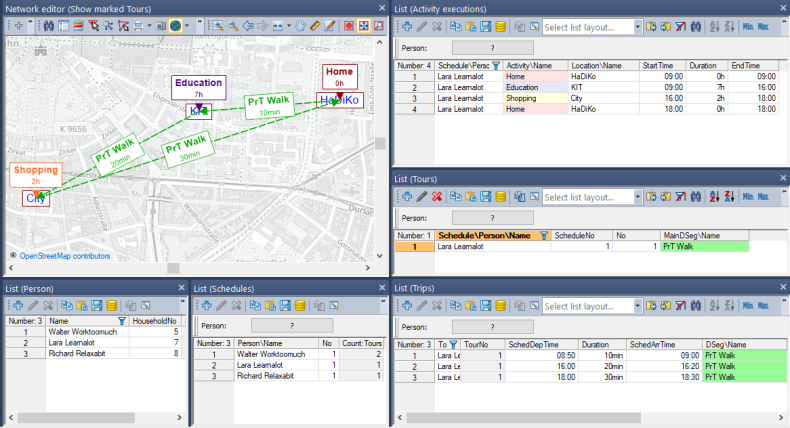The activity-based model (ABM) is an alternative approach for demand modeling that represents travel demand as a result of many individual travel decisions.
In classical macroscopic demand models, the population is aggregated into behaviorally homogeneous person groups. For each group, activity pairs or activity chains are modeled. The calculation of demand is based on the (usually negative) utility of changes in location. The results of a macroscopic demand model are several trip matrices differentiated by person group, trip purpose, and mode.
In contrast, in activity-based models (ABM) the focus lies on individual persons and their disaggregated mobility. Activity-based models are microscopic demand models in which mobility decisions of all persons are individually simulated as discrete choices. Such a choice can be a long-term choice such as the choice of workplace, or a short-term decision such as the mode of a trip. Activity-based models are popular for some areas of demand modeling, as they model the behavior of individuals in a very intuitive way and have the potential to better account for some aspects of mobility (e.g. differentiation according to peak and off-peak times, more precise modeling of PuT access, multi-modality) than aggregated models.
The individuals are represented as a "synthetic population". The persons in a synthetic population are not an exact reproduction of the true population, but are typically generated by suitable cloning of surveyed persons (e.g. from household surveys) on the basis of statistical socio-demographic data. The choices of the persons depend, among other things, on their characteristics. As a result of the demand model, schedules are generated in the form of sequences of activity executions. The schedules contain information about the activities, for example start times, duration and locations, as well as the tours and trips including the choice of mode.
Although the concepts of activity-based models are similar, no clear common structure has emerged that is used as a generally accepted standard among transport planners. Therefore, activity-based models may differ in many respects. This concerns the definitions of the utility functions, the decisions considered and their order, the decision models themselves, as well as various model parameters.
PTV Visum therefore offers two approaches to microscopic demand modeling. Firstly, external ABMs can be integrated into a Visum model, with PTV Visum forming the framework and the external ABM carrying out the demand calculations (corresponding importers and exporters exist for the ABM software ActivitySim (User Manual: ActivitySim interface)). PTV Visum provides the necessary data structures, data management tools, and COM APIs. The integration of custom activity-based models in PTV Visum allows you to benefit from all other features such as handling of large data sets, model sequence control, powerful assignments, and evaluation tools.
The second approach, which is probably more recommendable for most users, is the use of Visum's ABM procedure (ABM Nested Demand). These are based on the functionality of conventional 4-stage models and are therefore easy to understand in terms of their structure and also easy to operate.
PTV Visum also provides functionality for file input and output, visualizations, and analysis in the area of disaggregated demand. The synthetic population is calculated with external software (we recommend using PopulationSim) 1and can be imported to PTV Visum. The data of the persons and households are stored in the object types persons and households (Managing persons and Managing households). Like other activity locations, households are also located by means of coordinates. All objects of the ABM data model can be extended by user-defined attributes.
The results are saved as schedules, activity executions, tours, and trips (Managing tours and Managing trips). Lists are available for editing and evaluating these object types. They are synchronized with the network editor, which allows geographical examination of a single tour, as shown in the following figure.


